35 years of Expo 86: re-learning lessons on transportation
35 years of Expo 86: re-learning lessons on transportation
2021 marks the 35th anniversary of Expo 86, an event that thrust Vancouver into the world spotlight and helped redefine Metro Vancouver as a global hub.
Expo 86 was originally pitched as “Transpo 86” with the idea that it would be a modest transportation exhibition to celebrate Vancouver’s 100th anniversary. The size, scale, and cost of Expo 86 went on to greatly exceed what was initially planned but transportation as a defining theme stuck around. Not only did Expo 86 throw Metro-Vancouver onto the world stage, but it taught us valuable lessons about the future of transportation in B.C. and around the world.
Getting around the Expo
The Expo proudly displayed the most modern forms of transportation at the time, monorails, sea ferries, gondolas, and of course the newly opened rapid transit system, dubbed the “SkyTrain.”
It was one of the premier attractions and achievements of Expo 86, and was prominently visited by Princess Diana and Prince Charles during their visit to the Expo in May 1986.
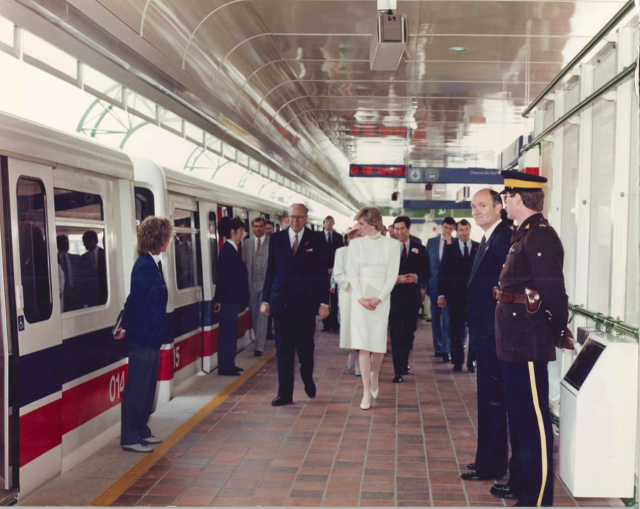
During the Expo, a third platform at Stadium Station provided shuttle service between the main site of Expo 86 and Canada Place, which was the Canada pavilion. This allowed it to functionally remain part of the Expo grounds even though it was physically at another location.
The SkyTrain, which originally operated from New Westminster Station to Waterfront Station, allowed people from across the region to travel and from the exhibition grounds with ease.
The success of SkyTrain at Expo 86 led to future expansion to the system being included in Transport 2021, a 1991 plan to expand the transit system very much like Transport 2050, an ongoing plan with the same purpose.
Later, the SkyTrain would expand to Columbia, Scott Road, Surrey Central and finally King George Station in the early 1990s. In the early 2000s, with the Millennium Line’s arrival, the SkyTrain line became the SkyTrain network and this original line was renamed the Expo Line.
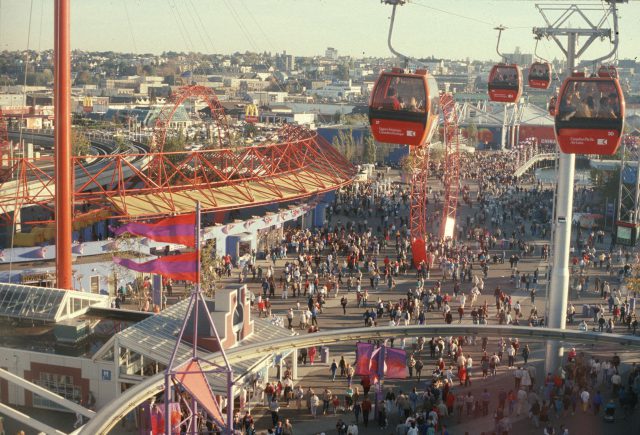
Aside from SkyTrain, Expo 86 also showed off another form of rapid rail transportation, the monorail. Though the 5.4-kilometre monorail system didn’t stick around Vancouver long term – it’s currently serving in a theme park in England– it did make a huge impact on attendees with over 10.5 million riders over the course of the Expo’s six months. The success of the monorail proved that there was a larger desire for more rapid rail transit in the region.
The gondolas featured at Expo 86 were known as the Gondola Skyrides and carried as many as 9.5 million visitors across zones and between pavilions. Today, gondolas remain in use across B.C. from the Sea to Sky and Peak to Peak gondolas as aerial cable cars are a popular method of travel for tourists. We’re also looking at the viability of bringing gondolas back to Metro Vancouver as a daily way of transporting commuters as a part of the Burnaby Mountain Gondola project.
Transportation Plazas
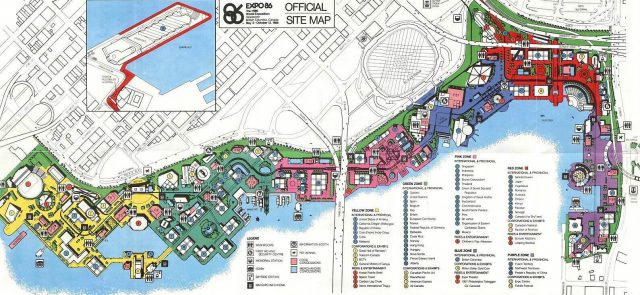
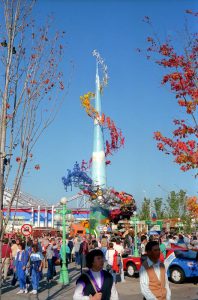
The Expo had nine main plazas across False Creek with three of them devoted to different modes of transportation: land, marine, and air.
Land Plaza was dedicated to showcasing vehicle travel and featured different modes of transportation that utilized roadways, from elephants and camels to scooters and even high-end Mercedes. Two main art exhibits within displayed the need to evolve travel away from roadways, “Transcending the Traffic” was an 86 foot tall spiraling sculpture created by Bill Lishman in honour of Terry Fox and “leg transportation.” The other was Highway 86, a 214 meter long 4 lane highway that featured 200 different vehicles all painted grey meant to showcase our over-reliance on highways.
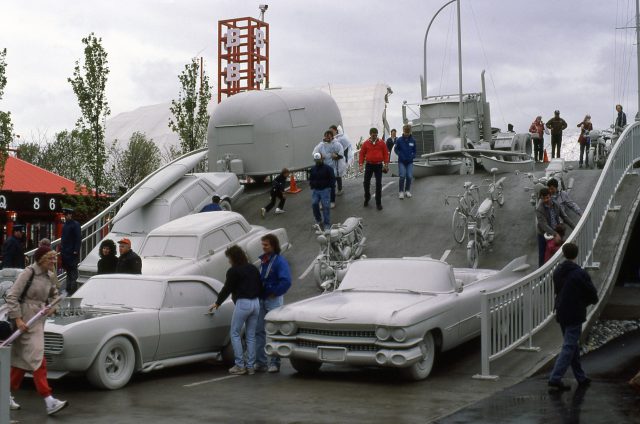
Marine Plaza hosted several hundred marine vessels from around the world, located on the site that Quayside Marina now calls home close to the Cambie Street Bridge. It showcased different cultures, boat-building methods, and the versatility of materials. From Italian gondolas to Peruvian reed-boats, to traditional Indigenous canoes the Marina Plaza demonstrated how different cultures work differently to solve the same problems. The Marine Plaza was one of the main hubs for the sea ferries that interconnected the Expo across False Creek, demonstrating the practicality of the sea-faring vessels being exhibited.
The Air Plaza was largely dedicated to looking towards the future of transportation, celebrating airplanes and space travel. The Plaza assembled every flying contraption that one could seemingly get their hands on, featuring early airplanes, kites, hot-air balloons, bi-planes, and even the nose of a Boeing 747. Air Plaza was meant as a celebration of human achievement as well as a place to provide inspiration for the future of air travel.
Expo 86 taught us valuable lessons about transportation and the future of Vancouver, from inspiring and expanding the SkyTrain network, to trying to relieve congestion from our roadways, to looking at other cultures and eras for inspiration to solve the problems that have impacted us over the last 35 years.
Right now we’re hoping to impact the future of transportation in the same way with Transport 2050. Unfortunately, we can’t hold a world exhibition, but you can still have your say on the future of transit in Metro Vancouver at transport2050.ca.
Did you visit Expo 86? Share your memories so we can reminisce together below.


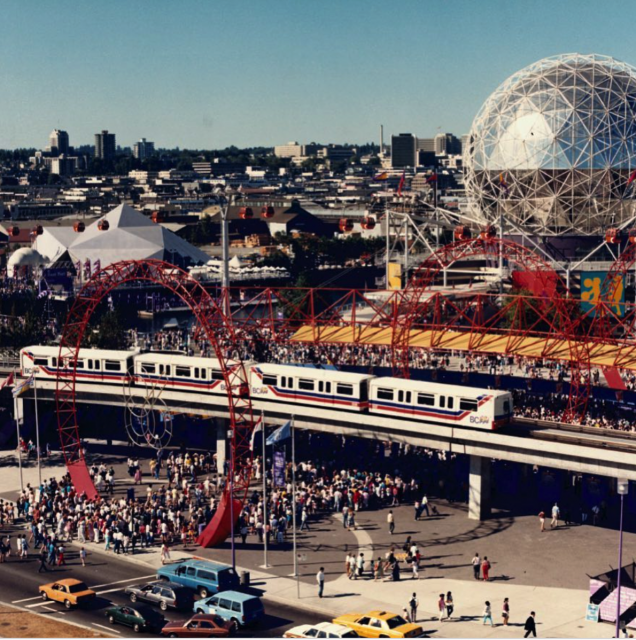




Interested in reading more about Expo 86? Checkout our blog post for the 30th anniversary here: https://buzzer.translink.ca/2016/05/then-and-now-30-years-of-expo/
My friends and I had a seasons pass. I remember hopping from one pavillion to another and the BC pavillion was one of the best offering a film that highlighted the beauty of our province. The now Science World venue also offered a great feature. I’m sorry we don’t view them on anniveraries. The monorail made it very easy to get around. We also went to the floating McDonalds! The evening laser show…was spectacular!